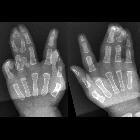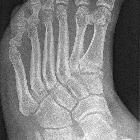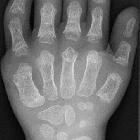Polydaktylie
























Polydactyly (less commonly called hyperdactyly) refers to the situation where there are more than the usual number of digits (five) in a hand or foot. It can be broadly classified as:
- preaxial polydactyly: extra digit(s) towards the thumb/hallux (radially)
- postaxial polydactyly: extra digit(s) towards little finger/toe (ulnar)
- central polydactyly: middle three digits are involved
Epidemiology
Estimated incidence is different for pre and postaxial polydactyly :
- postaxial: ~1 in 3000
- preaxial: ~1 in 7000
Central polydactyly is the rarest encountered.
In addition, there may be a greater prevalence in individuals of African descent (particularly for postaxial polydactyly) .
Pathology
Associations
A large proportion of polydactyly is isolated although they can be associated with an immense amount of anomalies which include:
- aneuploidic syndromic
- trisomy 13: tends to give postaxial polydactyly
- non-aneuploidic syndromic
- Bardet-Biedl syndrome: often postaxial
- Carpenter syndrome
- fetal valproate syndrome
- hydrolethalus syndrome
- Joubert syndrome
- Juberg-Hayward syndrome
- Lhermitte duclos disease
- Meckel Gruber syndrome: tends to be postaxial
- McKusick-Kaufman syndrome: postaxial
- megalencephaly, polymicrogyria, polydactyly, and hydrocephalus (MPPH) syndrome
- oral-facial-digital syndromes
- oral-facial-digital syndrome (OFDS) type II - Mohr syndrome: postaxial
- oral-facial-digital syndrome (OFDS) type VI: postaxial
- Pallister-Hall syndrome
- short rib polydactyly syndrome(s)
- skeletal dysplasias
- Smith-Lemli-Opitz syndrome
- VACTERL association
- non-aneuploidic, non-syndromic
- macrodystrophia lipomatosa
- syndactyly: most common associated limb anomaly, it is then termed polysyndactyly
Significance
If it is an isolated anomaly it is incidental and not of concern but if associated with another anomaly it then carries a vastly variable prognosis dependent on the rest of the syndrome.
Radiographic features
Other than describing polydactyly based on the position of the accessory digit, it can also be described by the number of total digits e.g. hexadactyly (six digits), or even, heptadactyly (seven digits). Indeed the presence of seven individual digits is exceedingly rare but has been reported twice .
Whilst radiology has little role in the diagnosis of polydactyly it is important in two ways:
History and etymology
The term "polydactyly" is derived from the Greek words "πολύς - polus" (many) and "δάκτυλος - daktulos" (finger).
Siehe auch:
- Pätau-Syndrom
- Meckel-Syndrom
- Ellis-van-Creveld-Syndrom
- Skelettdysplasie
- Syndaktylie
- VACTERL-Assoziation
- asphyxierende Thoraxdysplasie (Jeune-Syndrom)
- Trisomie 18
- Lhermitte-Duclos-Syndrom
- macrodystrophia lipomatosa
- Fetales Valproat-Syndrom
- Bardet-Biedl syndrome
- postaxiale Polydaktylie
- Carpenter syndrome
- angeborene Handfehlbildungen
- chondroectodermal dysplasia
- hydrolethalus syndrome
- Joubert-Syndrom
- Smith-Lemli-Opitz-Syndrom
- Kurzripp-Polydaktylie-Syndrome
- Pallister-Hall-Syndrom
- McKusick-Kaufman-Syndrom
- Varadi-Papp-Syndrom
- Laurence-Moon-Biedl-Bardet-Syndrom
- Polysyndaktylie
- Noack syndrome
- Oro-fazio-digitales Syndrom
- Goodman syndrome
- Sakati Nyhan syndrome
- Meckel-Gruber-Syndrom
- Holzgreve-Wagner-Rehder-Syndrom
- C-Syndrom
und weiter:
- obstetric curriculum
- cyllosoma
- Mesomelie
- fetal conditions associated with maternal diabetes
- Tibiale Hemimelie
- fetal pleural effusion
- VATER
- Akrorenales Syndrom
- Thalidomid-Embryopathie
- acrocephalosyndactyly
- dysencephalia spanchnocystica
- Mesomele Dysplasie
- kongenitale Anomalien der Finger
- mesoectodermal dysplasia
- VATER anomaly
- obstructive cystic renal dysplasia
- Salonen-Herva-Norio syndrome
- acrocephalopolysyndactyly
- Tetradaktylie
- acrocephalopolysyndactyly type II
- hydrolethalus
- Eaton-McKusick-Syndrom
- Oligodaktylie
- ectrodactyly-ectrodermal dysplasia-clefting syndrome
- Elejalde-Syndrom
- 7-dehydrocholesterol reductase deficiency
- Bakrania-Ragge-Syndrom
- Greig-Syndrom
- kongenitale Anomalien der Zehen
- präaxiale Polydaktylie
- central polysyndactyly
- duplicated distal phalanx of great toe
- Doppeldaumen

 Assoziationen und Differentialdiagnosen zu Polydaktylie:
Assoziationen und Differentialdiagnosen zu Polydaktylie:












